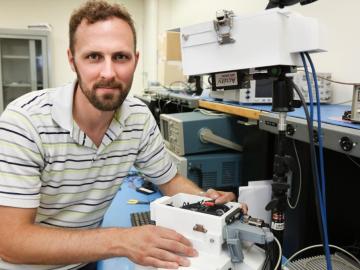
Filter News
Area of Research
- (-) Energy Science (15)
- (-) Neutron Science (15)
- (-) Quantum information Science (1)
- Biological Systems (1)
- Biology and Environment (26)
- Computational Biology (2)
- Computational Engineering (1)
- Computer Science (4)
- Fusion and Fission (3)
- Fusion Energy (1)
- Isotopes (5)
- Materials (9)
- Materials for Computing (1)
- National Security (18)
- Nuclear Science and Technology (1)
- Supercomputing (52)
News Type
News Topics
- (-) Artificial Intelligence (8)
- (-) Biomedical (13)
- (-) Cybersecurity (6)
- (-) Mercury (2)
- (-) Security (4)
- (-) Summit (4)
- 3-D Printing/Advanced Manufacturing (50)
- Advanced Reactors (2)
- Big Data (3)
- Bioenergy (16)
- Biology (9)
- Biotechnology (2)
- Buildings (27)
- Chemical Sciences (7)
- Clean Water (9)
- Composites (11)
- Computer Science (26)
- Coronavirus (13)
- Critical Materials (5)
- Energy Storage (47)
- Environment (39)
- Fossil Energy (2)
- Grid (30)
- High-Performance Computing (4)
- Hydropower (3)
- Machine Learning (5)
- Materials (24)
- Materials Science (24)
- Mathematics (3)
- Microelectronics (1)
- Microscopy (7)
- Nanotechnology (7)
- National Security (2)
- Neutron Science (79)
- Nuclear Energy (5)
- Partnerships (4)
- Physics (3)
- Polymers (7)
- Quantum Computing (1)
- Quantum Science (9)
- Simulation (2)
- Space Exploration (5)
- Statistics (1)
- Transportation (48)
Media Contacts

Each year, approximately 6 billion gallons of fuel are wasted as vehicles wait at stop lights or sit in dense traffic with engines idling, according to US Department of Energy estimates.

Students often participate in internships and receive formal training in their chosen career fields during college, but some pursue professional development opportunities even earlier.

Scientists at Oak Ridge National Laboratory studying quantum communications have discovered a more practical way to share secret messages among three parties, which could ultimately lead to better cybersecurity for the electric grid

Sometimes solutions to the biggest problems can be found in the smallest details. The work of biochemist Alex Johs at Oak Ridge National Laboratory bears this out, as he focuses on understanding protein structures and molecular interactions to resolve complex global problems like the spread of mercury pollution in waterways and the food supply.

![Coexpression_hi-res_image[1].jpg Coexpression_hi-res_image[1].jpg](/sites/default/files/styles/list_page_thumbnail/public/Coexpression_hi-res_image%5B1%5D_0.jpg?itok=ww635BCP)
While studying the genes in poplar trees that control callus formation, scientists at Oak Ridge National Laboratory have uncovered genetic networks at the root of tumor formation in several human cancers.

To learn more about interactions between drug molecules and micelles, Associate Professor Megan Robertson and graduate students Tyler Cooksey and Tzu-Han Li from the University of Houston (UH) are using neutrons at the Department of Energy’s (DOE’s) Oak Ridge National Laboratory (ORNL).
![2018-P07635 BL-6 user - Univ of Guelph-6004R_sm[2].jpg 2018-P07635 BL-6 user - Univ of Guelph-6004R_sm[2].jpg](/sites/default/files/styles/list_page_thumbnail/public/2018-P07635%20BL-6%20user%20-%20Univ%20of%20Guelph-6004R_sm%5B2%5D.jpg?itok=hUSyvkP0)
A team of scientists, led by University of Guelph professor John Dutcher, are using neutrons at ORNL’s Spallation Neutron Source to unlock the secrets of natural nanoparticles that could be used to improve medicines.

Biologists from Oak Ridge National Laboratory and the Smithsonian Environmental Research Center have confirmed that microorganisms called methanogens can transform mercury into the neurotoxin methylmercury with varying efficiency across species.

As leader of the RF, Communications, and Cyber-Physical Security Group at Oak Ridge National Laboratory, Kerekes heads an accelerated lab-directed research program to build virtual models of critical infrastructure systems like the power grid that can be used to develop ways to detect and repel cyber-intrusion and to make the network resilient when disruption occurs.


